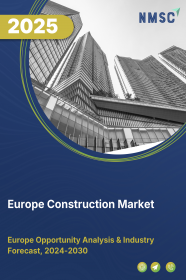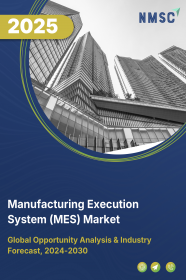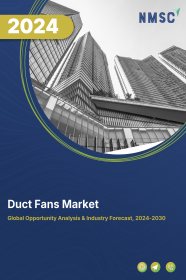
Europe Construction Market by Type (Renovation and New Construction), and by Sector (Real Estate, Infrastructure, and Industrial)–Opportunity Analysis and Industry Forecast, 2024–2030
Industry: Construction & Manufacturing | Publish Date: 28-Mar-2025 | No of Pages: 161 | No. of Tables: 122 | No. of Figures: 67 | Format: PDF | Report Code : CM2193
US Tariff Impact on Europe Construction Market
Trump Tariffs Are Reshaping Global Business
Europe Construction Market Overview
The Europe Construction Market size was valued at USD 2.11 trillion in 2023, and is predicted to reach USD 2.78 trillion by 2030, at a CAGR of 4.8% from 2024 to 2030.
The construction market, also referred to as infrastructure, plays a crucial role in the economy, encompassing the entire process from initial planning to the ongoing maintenance of various physical structures, including infrastructure, buildings, and facilities. This sector engages in a diverse range of projects, including residential, commercial, industrial, civil engineering, and institutional infrastructure developments.
It involves a multitude of stakeholders, such as architects, engineers, contractors, suppliers, developers, investors, and government agencies. The industry is poised for positive growth, driven by an increased emphasis on environmentally friendly practices such as the utilization of green building materials and energy-efficient designs. Additionally, factors such as rising per capita income in emerging economies and low-interest rates in developed countries are expected to further stimulate the expansion of the infrastructure market.
Government Support is a Catalyst for Growth in Europe's Infrastructure Sector
The construction market in Europe is witnessing significant growth, propelled by robust government backing and the execution of major infrastructure initiatives. Key drivers behind this expansion include substantial investments in renewable energy, transportation enhancements, and the adoption of sustainable infrastructure methods.
Noteworthy projects, including airport expansions, railway modernizations, and the installation of renewable energy sources, underscore the sector's pivotal role in advancing regional infrastructure. Moreover, Europe is currently directing considerable resources towards the energy sector to sustain overall industry growth. Despite encountering challenges such as material shortages and geopolitical uncertainties in specific regions, the overall outlook remains optimistic. The infrastructure industry continues to play a vital role in fostering economic development and advancing infrastructure throughout Europe.
Infrastructure Projects is Shaping the Growth Trajectory of Europe's Infrastructure Industry
The infrastructure sector in Europe is experiencing remarkable growth driven by the implementation of major infrastructure projects and robust government backing. Key factors fueling this expansion include substantial investments in renewable energy, transportation upgrades, and the adoption of sustainable infrastructure practices.
Prominent endeavors such as airport expansions, railway modernizations, and renewable energy installations underscore the sector's pivotal role in enhancing regional infrastructure. Additionally, Europe's significant allocation of resources towards the energy sector aims to sustain overall industry growth. Despite encountering challenges such as material shortages and geopolitical uncertainties in certain regions, the overall outlook remains positive. Across Europe, the infrastructure industry continues to be a linchpin in fostering economic development and advancing infrastructure initiatives.
Navigating Regulatory Complexities Challenges the Infrastructure Market Growth
The infrastructure market grapples with formidable challenges stemming from stringent regulatory frameworks. Infrastructure endeavors encounter hurdles due to the intricate web of government regulations and permitting processes. Infrastructure projects typically require a multitude of permits and approvals from governmental bodies at local, regional, and national levels. These permits encompass zoning regulations, environmental assessments, compliance with building codes, safety standards, and various regulatory requirements. Lengthy permit acquisition processes, bureaucratic inefficiencies, and regulatory disparities among jurisdictions can significantly extend project timelines and inflate costs.
Moreover, fluctuations in regulations or unexpected policy changes can disrupt ongoing projects and deter potential investments. For instance, the United States Environmental Protection Agency (EPA) oversees various aspects of the infrastructure sector, including air quality, lead management, waste disposal, and water regulations. The EPA's compliance assistance centers provide resources to facilitate environmental compliance during demolition activities, the recycling of infrastructure materials, and the proper disposal of refrigeration and air-conditioning equipment.
Integration of Digitalization and BIM Presents Lucrative Opportunity for Market Expansion
The infrastructure sector is experiencing a significant transformation through the integration of digitalization and the adoption of Building Information Modeling (BIM), harnessing advanced technologies to improve efficiency, precision, and collaboration across various projects. BIM, a sophisticated 3D modeling tool, empowers stakeholders to create and manage digital representations of structures and infrastructure, facilitating enhanced coordination and communication among project teams.
For instance, in September 2022, the National Institute of Building Sciences (NIBS) launched the U.S. National Building Information Management (BIM) Program, aiming to revolutionize the infrastructure industry and achieve unparalleled levels of industrial efficiency through digitalization. This initiative addresses the inadequate level of digitalization within the U.S. infrastructure sector, that hampers the transformation of lifecycle work processes to become more efficient, cost-effective, resilient, and safer to construct and maintain.
Germany Holds the Dominant Market Share in Europe Infrastructure Market
The infrastructure sector in Germany is witnessing a surge in growth propelled by an increasing number of government initiatives aimed at developing new infrastructure projects, including railways and power grids. A notable example of this trend is the USD 49.73 billion infrastructure program jointly launched by the German Federal Government and Deutsche Bahn (DB) in September 2023, targeting the enhancement of the rail network and stations.
This ambitious endeavor aims to significantly enhance train traffic punctuality and establish the necessary conditions to fulfill transportation policy objectives for both passenger and freight traffic. These government-driven initiatives are poised to exert a significant impact on Germany's infrastructure sector.
Additionally, the expansion of the overall market is fueled by the remarkable growth of the infrastructure sector, that plays a pivotal role in contributing to the country's GDP. According to the UNECE report, the infrastructure sector's share in Germany's GDP reached 5.7% in 2022, surpassing the contributions of other European nations such as Denmark, Belgium, and Italy. This substantial involvement of the infrastructure sector in Germany's economy serves as a crucial driving force behind the market's overall growth trajectory.
Sweden to Witness Substantial Growth in the Europe Infrastructure Market
The construction market in Sweden is currently experiencing robust growth, driven by an increasing number of government-supported infrastructure projects. These initiatives primarily focus on the development of railway and transportation systems, driving the expansion of the industry. Additionally, the Swedish government unveiled a significant national infrastructure investment plan spanning from 2022 to 2027.
Valued at USD 91.27 billion, this strategic initiative aims to modernize and enhance the country's infrastructure, with a particular emphasis on transportation networks. The investment plan includes substantial rail-centric projects, such as the expansion of the East Coast Line, the establishment of a four-track line between Uppsala and Stockholm County, and the extension of the Gavle – Kringlan rail section.
Furthermore, the expansion of the overall market is attributed to the significant growth of the construction market, that holds a substantial portion of the GDP. According to a report by UNECE, the infrastructure sector's share in Sweden's GDP was 6.6% in 2022, surpassing that of other European countries such as Spain, Norway, and the Netherlands. This substantial contribution of the infrastructure sector to Sweden's GDP serves as a key driver of the market's overall growth.
Competitive Landscape
The market players operating in the Europe infrastructure industry include China State Construction Engineering Corp. Ltd. (CSCEC), China Railway Group Ltd. (CREC), China Railway Construction Corp. Ltd. (CRCC), China Communications Construction Group Ltd. (CCCC), Metallurgical Corporation of China Ltd. (MCC), Power Construction Corp. of China, Vinci SA, China Energy Engineering Corp. (CEEC), Shanghai Construction Group (SCG), Bouygues Group, and others.
Europe Construction Market Key Segments
By Type
-
Renovation
-
New Construction
By Sector
-
Real Estate
-
Residential
-
Affordable
-
Luxury
-
-
Commercial
-
Retail Buildings
-
Office Buildings
-
Hospitality
-
Healthcare Facilities
-
Educational Institutes
-
Entertainment Ventures
-
-
-
Infrastructure
-
Transportation
-
Airport
-
Port
-
Rail
-
Road
-
-
Water and Wastewater
-
Energy
-
Telecommunication
-
-
Industrial
-
Manufacturing Plant
-
Warehouses
-
Power Plants
-
Oil Refineries
-
Chemical Plants
-
By Country
-
UK
-
Germany
-
France
-
Italy
-
Spain
-
Denmark
-
Netherlands
-
Finland
-
Sweden
-
Norway
-
Russia
-
Austria
-
Hungary
-
Czech Republic
-
Poland
-
Rest of Europe
Key Players
-
China State Construction Engineering Corp. Ltd. (CSCEC)
-
China Railway Group Ltd. (CREC)
-
China Railway Construction Corp. Ltd. (CRCC)
-
China Communications Construction Group Ltd. (CCCC)
-
Metallurgical Corporation of China Ltd. (MCC)
-
Power Construction Corp. of China
-
Vinci SA
-
China Energy Engineering Corp. (CEEC)
-
Shanghai Construction Group (SCG)
-
Bouygues Group
REPORT SCOPE AND SEGMENTATION:
|
Parameters |
Details |
|
Market Size in 2023 |
USD 2.11 Trillion |
|
Revenue Forecast in 2030 |
USD 2.78 Trillion |
|
Growth Rate |
CAGR of 4.8% from 2024 to 2030 |
|
Analysis Period |
2023–2030 |
|
Base Year Considered |
2023 |
|
Forecast Period |
2024–2030 |
|
Market Size Estimation |
Trillion (USD) |
|
Growth Factors |
|
|
Countries Covered |
16 |
|
Companies Profiled |
10 |
|
Market Share |
Available for 10 companies |
|
Customization Scope |
Free customization (equivalent up to 80 working hours of analysts) after purchase. Addition or alteration to country, regional, and segment scope. |
|
Pricing and Purchase Options |
Avail customized purchase options to meet your exact research needs. |

















 Speak to Our Analyst
Speak to Our Analyst

















